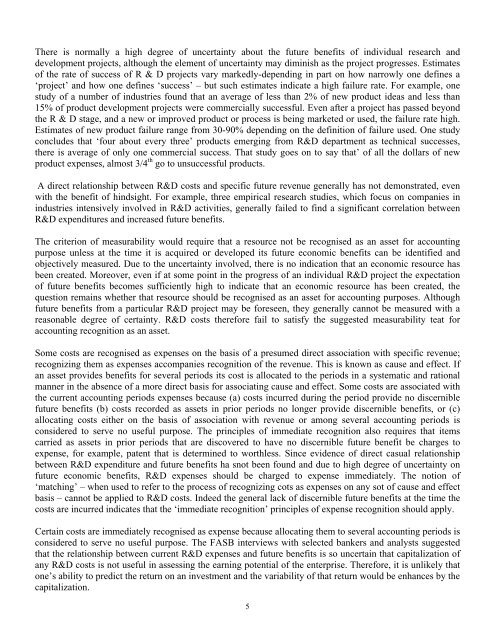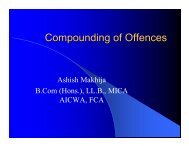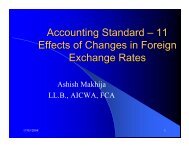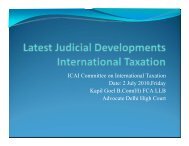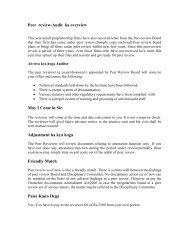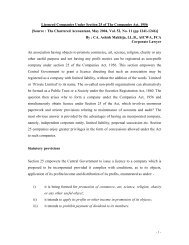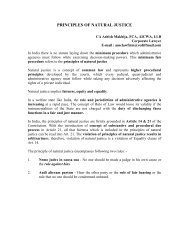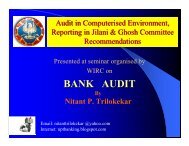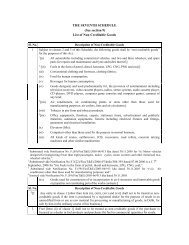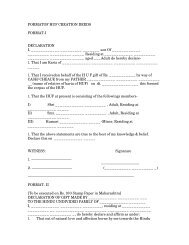dsrawat, fca intangible assets
dsrawat, fca intangible assets
dsrawat, fca intangible assets
Create successful ePaper yourself
Turn your PDF publications into a flip-book with our unique Google optimized e-Paper software.
There is normally a high degree of uncertainty about the future benefits of individual research anddevelopment projects, although the element of uncertainty may diminish as the project progresses. Estimatesof the rate of success of R & D projects vary markedly-depending in part on how narrowly one defines a‘project’ and how one defines ‘success’ – but such estimates indicate a high failure rate. For example, onestudy of a number of industries found that an average of less than 2% of new product ideas and less than15% of product development projects were commercially successful. Even after a project has passed beyondthe R & D stage, and a new or improved product or process is being marketed or used, the failure rate high.Estimates of new product failure range from 30-90% depending on the definition of failure used. One studyconcludes that ‘four about every three’ products emerging from R&D department as technical successes,there is average of only one commercial success. That study goes on to say that’ of all the dollars of newproduct expenses, almost 3/4 th go to unsuccessful products.A direct relationship between R&D costs and specific future revenue generally has not demonstrated, evenwith the benefit of hindsight. For example, three empirical research studies, which focus on companies inindustries intensively involved in R&D activities, generally failed to find a significant correlation betweenR&D expenditures and increased future benefits.The criterion of measurability would require that a resource not be recognised as an asset for accountingpurpose unless at the time it is acquired or developed its future economic benefits can be identified andobjectively measured. Due to the uncertainty involved, there is no indication that an economic resource hasbeen created. Moreover, even if at some point in the progress of an individual R&D project the expectationof future benefits becomes sufficiently high to indicate that an economic resource has been created, thequestion remains whether that resource should be recognised as an asset for accounting purposes. Althoughfuture benefits from a particular R&D project may be foreseen, they generally cannot be measured with areasonable degree of certainty. R&D costs therefore fail to satisfy the suggested measurability teat foraccounting recognition as an asset.Some costs are recognised as expenses on the basis of a presumed direct association with specific revenue;recognizing them as expenses accompanies recognition of the revenue. This is known as cause and effect. Ifan asset provides benefits for several periods its cost is allocated to the periods in a systematic and rationalmanner in the absence of a more direct basis for associating cause and effect. Some costs are associated withthe current accounting periods expenses because (a) costs incurred during the period provide no discerniblefuture benefits (b) costs recorded as <strong>assets</strong> in prior periods no longer provide discernible benefits, or (c)allocating costs either on the basis of association with revenue or among several accounting periods isconsidered to serve no useful purpose. The principles of immediate recognition also requires that itemscarried as <strong>assets</strong> in prior periods that are discovered to have no discernible future benefit be charges toexpense, for example, patent that is determined to worthless. Since evidence of direct casual relationshipbetween R&D expenditure and future benefits ha snot been found and due to high degree of uncertainty onfuture economic benefits, R&D expenses should be charged to expense immediately. The notion of‘matching’ – when used to refer to the process of recognizing cots as expenses on any sot of cause and effectbasis – cannot be applied to R&D costs. Indeed the general lack of discernible future benefits at the time thecosts are incurred indicates that the ‘immediate recognition’ principles of expense recognition should apply.Certain costs are immediately recognised as expense because allocating them to several accounting periods isconsidered to serve no useful purpose. The FASB interviews with selected bankers and analysts suggestedthat the relationship between current R&D expenses and future benefits is so uncertain that capitalization ofany R&D costs is not useful in assessing the earning potential of the enterprise. Therefore, it is unlikely thatone’s ability to predict the return on an investment and the variability of that return would be enhances by thecapitalization.5


